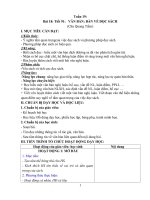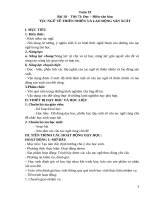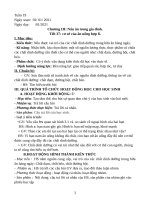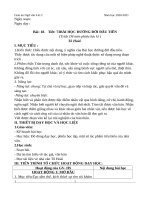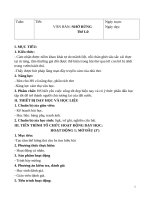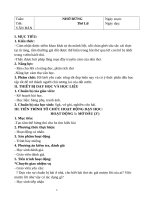Giáo án tiếng anh 9 kì 2 soạn chuẩn cv 5512 mới nhất
Bạn đang xem bản rút gọn của tài liệu. Xem và tải ngay bản đầy đủ của tài liệu tại đây (1.41 MB, 276 trang )
Period 55: UNIT 7: RECIPES AND EATING HABITS
LESSON 1: GETTING STARTED
SUBJECT: ENGLISH 9
I. OBJECTIVES:
1. Knowledge:
- By the end of the theme SS can use some vocabularies and structures to talk
about their favourite dishes and recipes for dishes
2. Competences:
To develop self- studying skill, communicating and co-opererating skills,
problem- solving and creating skills.
3. Qualities:
To educate ss mercifulness, patriotism, studiousness, honesty and responsibility.
II. TEACHING AIDS:
- Students: Materials: book, board..
- Teacher: Equipment : laptop, projector.
II. TEACHING PROCEDURES:
1. Class organization:
* Checking:
- Talk about one of the wonders you like best
2. New lesson:
A. Activity 1: Determining the task:
* Chatting:
*Aims: To help ss to relate to the topic of unit 7.
*Content: Ask Ss what their favorite dishes are
* Output: Ss can relate to the topic of unit 7
* Process:
1.Transfering the task:
1
- Ask Ss to work in group to do the task.
2. Doing the task:
In groups of three, ask what their favorite dishes are
3. Reporting the result and discussing:
- SS present
4. Feedback:
- T corrects and gives the remarks
B. Activity 2: Form the new knowledge:
T AND SS’ ACTIVITIES
MAIN CONTENTS
I. Teaching vocabulary
*Aims: Ss know how to read new words, identify their meanings and use them to make
sentences and know what they are going to listen and read.
*Contents: Vocabularyabout recipe and eating habits.
* Output: Almost all the students can do this task well
* Process:
1. Transfering the task:
I. New words :
- Elicit some new words from the
pictures and situations , realias …..
2. Doing the task:
T: reads new words.
- T: writes new words on the board.
- SS: listen and repeat in individual first
then the whole class.
3. Reporting the result and discussing:
- ingredients
- prawn (n)
- celery (n)
- spring onion (n)
- mayonnaise (n)
- to boil
- to drain
- to peel
- to chop
- to starve
thành phần
tơm
cần tây
hành lá
xốt
luộc
để ráo
lột vỏ
chặt
đói
Kho : to cook with sauce
Nướng : to grill
Quay : to roast
Rán, chiên : to fry
Xào, áp chảo : to saute
- Call 3- 4 SS to read the words again.
- Checks vocab : slap the board.
4. Feedback:
2
- T corrects and gives the remarks.
Hầm, ninh : to stew
Hấp : to steam
Ask Ss to open their books and look at
the picture and the phrase under
GETTING STARTED. Ask them some
questions:
Who can you see in the picture?
What is there on the table?
Where are the people?
What do you think the people in the
picture are talking about?
C. Activity 3: Practice
*Aims:SS get the content of the conversation between Nick and Mi and then complete
the exercises
*Contents: read the conversation
* Output: Almost all SS can complete the task(s).
* Process:
Ex1:
Ex1. Listen and read.
1. Transfering the task:
- Explain the requirement of the task to
SS
2. Doing the task:
- SS listen to the conversation
- Ss work in pairs to complete the tasks.
3. Reporting the result and discussing:
- T calls two Ss to write on the board.
- Other SS give their answers orally.
4. Feedback:
- T corrects and gives the remarks.
3
a.Can you find a word that means:
a. Can you find a word that means:
Have Ss work independently to find the
words with the given meanings in the
dialogue. Allow Ss to share
their answers before asking them to
discuss as a class. Remember to ask Ss
to read out the lines in the
dialogue that contain the words. Quickly
write the correct answers on the board.
Key:
1. starter
2. versatile
3. drain
4. peel
5. chop
6. combine
- Have Ss look at the Watch out! box
and quickly read the information. If time
allows, ask Ss to make some
examples with the expressions.
b. Find all the words related to the
topic of food in the conversation. Put
them in the word webs.
Ask Ss to work in pairs and complete
the word webs. Call on one pair to write
their answers on the board. Other pairs
add more words if needed.
c . Answer the questions.
Have Ss read the questions to make sure
they
4
b.Find all the words related to the topic of
food in the conversation. Put them in the
word webs.
understand them. Ask them firstly to
answer
the questions without reading the
dialogue again. Have Ss exchange their
answers with a classmate. Now ask them
to check their answers by reading the
dialogue again. Ask for Ss’ answers
c . Answer the questions.
Key:
1. Nick’s mum.
2. Because it’s simple and delicious.
3. In the summertime.
4. They are versatile, and you can use lots of
different ingredients in a salad.
Ex2.
5. Nick’s mum boils and drains the prawns.
- Explain the requirement of the task to Nick washes the celery, peels the prawns, and
mixes the ingredients. Mi washes the spring
SS
onions, chops the celery and spring onions,
- Ss look at the pictures. Tell Ss that in
and mixes the ingredients.
the box are some dishes from different
6. Because he is finding it difficult to wait for
countries in the world.
one hour.
- Ask Ss to write these dishes under the Ex2. Write the name of each dish in the box
pictures
under each picture.
- Ss listen to the text
A. Cobb salad
B. sushi
C. steak pie
D. fajitas
E. lasagne
F. mango sticky
rice
G.
beef noodle
soup
H. curry
- Ss work in pairs to complete the task.
- T calls two Ss to write on the board.
- Other SS give their answers orally.
- T corrects and gives the remarks.
Ex3
a.
Have Ss work in pairs to discuss what
country in the box is associated with
each dish in 2. Check and confirm the
A. Cobb xà
lách
B. sushi
C. bánh bít
tết
D. fajitas
D. mì ống Ý
F. Xơi xồi
Thái
G. phở bò
H. cà ri
Lasagna, hoặc Lasagne, (phát âm là
5
correct answers.
[lazaɲɲa], số nhiều [lazaɲɲe
b.
Ex3a .In pairs, discuss which country from
the box is associated with each dish in 2
Tell Ss to complete the sentences with
the names of the dishes in2. The
complete sentences will give Ss
information about these dishes. Call on
two Ss to write their answers on the
board.
- If time allows, T may organise a short
activity to check Ss’ short-term memory.
Have Ss close their books. Point
at each of Ss’ answers on the board and
quickly Ss have to call out the country
where the dish comes from.
A. The USA
B. Japan
C. The UK
D. Mexico
E. Italy
F. Thailand
G. Viet Nam
H. India
b. Fill each blank with the name of a dish in
2.
1. Lasagne
2. curry
3. steak pie
4. Fajitas
5. sushi
D. Activity 4: Application
*Aims:Help Sstalk about the name of some food
*Content:Make two big groups. One group names a service. The other group gives their
vision of that service in the future. Take turns to do this.
* Output: Almost all the students can complete the tasks
* Process:
1. Transfering the task:
4. Food quiz
- AskSs to work in groups to do the
quiz. The group which has the answers
the fastest is invited to read out
their answers. Elicit feedback from other
groups and ask them to add some other
answers.
1. beef
2. prawn, potato
3. cheese, butter, ice cream
2. Doing the tasks
- Ss work in groups to do the quiz. The
6
4. strawberry, lychee, cherry, pomegranate
5. broccoli, spinach, lettuce, celery, kohlrabi
group which has the answers the fastest
is invited to read out their answers.
Elicit feedback from other groups and
ask them to add some other answers.
T moves around to provide help (if
necessary)
3. Reporting the result and discussing:
- Ss play the game
- When time is up, ask the first group to
read out a question in their quiz. Ss from
other groups give the answers. Other Ss
decide if their answers are correct.
Continue the activity until all the groups
have read out all of their questions
4. Feedback:
- T gives the remarks.
3. Homework:
- Learn new words by heart.
- Read the conversation again.
-Copy the exercise into notebooks.
Period 56: UNIT 7: RECIPES AND EATING HABITS
LESSON 2: A CLOSER LOOK 1
SUBJECT: ENGLISH 9
I. OBJECTIVES:
1. Knowledge:
7
After the lesson students will be able to:
- use the lexical items related to dishes and ways of preparing and cooking food
- ask statement questions with the correct intonation
2. Competences:
To develop ss’ ss’ self- studying skill, communicating and co-opererating skills,
problem- solving and creating skills.
3. Qualities:
To educate ss about mercifulness, studiousness, honesty and responsibility.
II. TEACHING AIDS:
- Students: Materials: book, board..
- Teacher: Equipment : laptop, projector.
II. TEACHING PROCEDURES:
1. Class organization:
* Checking:
S1: goes to the board to write new words
- S2: answers some questions.
2. New lesson:
A. Activity 1: Determining the task:
Brainstorming
*Aims:To encourage Ss in their new lesson by playing a game
*Contents: Ask Ss to call out the types for preparing and cooking foods they
remember in the previous lesson. Tell them that in this lesson they are going to
learn some similar vebs
* Output: Ss use the language correctly when talking about recipes
* Process:
1.Transfering the task:
- Ask Ss to do the task.
2. Doing the task:
8
- Ss work individually
3. Reporting the result and discussing:
- SS answer the questions.
4. Feedback:
- T gives the remarks
B. Activity 2: Form the new knowledge
T AND SS’ ACTIVITIES
MAIN CONTENTS
I. Teaching Vocabulary
*Aims:Ss know how to read new words, identify their meanings and do some exercises
*Contents: new words
* Output:Students complete the exercises
* Process:
1. Transfering the task:
I. Vocabulary
- Explain the requirement of the task to - whisk: beat eggs, cream, etc., with a specia
SS
tool to add air and make the food light (đánh trứng
kem.,.)
2. Doing the task:
- slice: cut something into thin flat pieces (thái
- Teach some new words :
lát)
- grate: rub food (e.g. cheese) against a grater
- T: writes new words on the board.
in order to cut it into very small pieces (nạo)
- SS: listen and repeat in individual first - dip: put something quickly into a drink,
then the whole class.
sauce or batter and take it out again (nhúng)
3. Reporting the result and discussing: - chop: cut something into pieces with a knife
(chặt, cắt)
Call 3- 4 SS to read the words again.
- spread: put a layer of a substance evenly
Checking: rub out and remember.
onto the surface of something (phết)
- sprinkle: shake small pieces of something, or
4. Feedback:
drops of a liquid, on something (rắc)
- T corrects and gives the remarks.
- marinate: pour a mixture, usually containing
oil, wine or vinegar, and herbs and spices, over
9
meat or fish before it is cooked to add flavour or
make it tender (ướp)
C. Activity 3: Practice
*Aims: - Ss know how to do exercises.
*Content: Do exercises.
*Output: Students complete the exercises.
*Process:
1. Transfering the task:
Ex1. Write a food preparation verb from the box
- Explain the requirement of the task to under each picture.
A. Chop: chặt, cắt
SS
B. Slice: thái lát
C. grate : nạo
2. Doing the task:
D. marinate: ướp
- Ss work individually
E. whisk: đánh trứng
F. dip: nhúng
- Use the verbs correctly to talk about
G. sprinkle: rắc
food preparation.
H. spread: phết
3. Reporting the result and discussing:
- T calls two Ss to write on the board.
- Other SS give their answers orally.
4. Feedback:
- T corrects and gives the remarks
Ex1:
- Have Ss work individually to do this
exercise and then compare their answers
with a classmate.
Elicit the answers from Ss and quickly
write them on the board
Ex2:
The purpose of this exercise is to help Ss
10
Ex2. Complete the sentences with the correct
form of the verbs in 1.
Key:
1. chop; Slice
2.grates;
sprinkles
3. Marinate
4. whisk
5. Dip
6. spread
use the verbs correctly to talk about food
preparation. Ask Ss to work in pairs to do
the exercise. Check the answers as a
class. If time allows, have Ss make
sentences.
Ex3.
Have Ss do this exercise individually and
then compare their answers with a
partner. Check and confirm the correct
answers. Have Ss give the Vietnamese
translation of the words if needed.
Ex4a.
a. Ask Ss to answer the two questions.
Elicit their answers. Ask them if they
have ever eaten or made a pizza. If Ss
have eaten pizza, ask them if they like the
dish. If they have made a pizza
themselves, ask them to describe the
process of making one briefly.
Ex3. Match each cooking verb in A with its
definition in B.
Key:
1. g
2. f
3. h
4. c
5. e
6. a
7. d
8. b
Ex4a. What can you see in the pictures? Do
you know what dish these ingredients are used
for?
Key:
tomato sauce, onion, cheese, apple, bacon, pizza
base —> pizza
b. Complete the instructions below with the
verbs in 1 and 3. One verb is used twice.
Key:
1. Chop
2. Grate
3. Spread 4. Sprinkle
b. Have Ss complete the instructions 5. Spread 6. Bake
individually and then compare their
answers with a partner. Check the
answers as a class. Ask Ss who have not
made a pizza before if they can make a
pizza themselves after heading the
instructions.
II. Teaching pronunciation
*Aims:Help SS to learn and practice the Tones in statements used as questions
*Contents:.
* Output: Almost all the students can do this task
* Process
1. Transfering the task:
II. Pronunciation:
- Explain the requirement of the task.
Tones in statements used as questions
11
- Explain to Ss the meaning of
‘statement’ (a telling sentence that ends
with a full stop) and ‘statement question’
(used to check information; has the order
of a statement but ends with a question
mark).
- Have Ss listen to the recording
2. Doing the task:
Let them listen again and have them
repeat the sentences with a focus on the
tones
3. Reporting the result and discussing:
- SS read aloud.
4. Feedback:
Ex5. Listen to the conversations. Draw ↘ or
↗ at the end of each line. Practise the
conversations with a partner
- T corrects and gives the remarks
Ex5. Ask Ss to read through the three
conversations. Play the recording for Ss
to draw appropriate arrows to indicate
the intonation of each sentence. Have Ss
compare their answers in pairs. Call on
some pairs to read the conversations out
loud. Correct any mistakes.
For a more able class, have Ss work in
pairs and draw the arrows first. Then
play the recording for them to check
their answers.
D. Activity 4: Application
Aims:Help SS to learn and practice the Tones in statements used as questions
*Contents:. learn and practice the Tones in statements used as questions
* Output: Almost all the students can do this task
* Process
1.Transfering the learning task:
Ex6. a. Work in pairs. Complete the mini12
dialogues with suitable statement questions.
Ex6. a. Ask Ss to work in pairs to
complete the mini-dialogues with suitable
statement questions. Call on some pairs
to write their answers on the board. Give
b. Practise the dialogues using the correct
comments when needed.
intonation.
b Practise the dialogues using the
Suggested answer:
correct intonation.
1. You don't like pasta?/Don't like pasta?
Have Ss practise the dialogues and act
them out in front of the class with the
2. Add some salt?
correct intonation. Ask other Ss to
comment.
If time allows, let Ss write their own
dialogues with statement questions.
2. Doing the task:
Work in pairs.
3. Reporting the task result and discuss:
Calls on some sts to read loudly.
4. Giving the remarks to their doing the
task:
- Correct and give marks
- Feedback
13
Period 57: UNIT 7: RECIPES AND EATING HABITS
LESSON 3: A CLOSER LOOK 2
SUBJECT: ENGLISH 9
I. OBJECTIVES:
1. Knowledge: After the lesson students will be able to:
- use some quantifiers correctly
- write and use conditional sentences type 1 with modal verbs
2. Competences:
To develop ss’ ss’ self- studying skill, communicating and co-opererating skills,
problem- solving and creating skills.
3. Qualities:
To educate ss about mercifulness, patriotism, studiousness, honesty and
responsibility.
II. TEACHING AIDS:
- Students: Materials: book, board..
- Teacher: Equipment : laptop, projector.
II. TEACHING PROCEDURES:
1. Class organization:
* Checking
S1: Does A1- workbook
S2:Write the words and make sentences
2. New lesson:
14
A. Activity 1: Determining the task:
* Play game: Network
*Aims: To lead in the new lesson
*Contents: giving examples with quantifiers.
* Output: - Most ss can complete the task(s).
* Process:
1.Transfering the task:
- Write down all quantifiers that they know in two minutes. The winner in the pair
with has the most answers.
2. Doing the task:
- Students work in pairs
3. Reporting the result and discussing:
- SS present
4. Feedback:
- T corrects and gives the remarks.
B. Activity 2: Form the new knowledge:
T AND SS’ ACTIVITIES
MAIN CONTENTS
I. Teaching Grammar:
*Aims:Help SS to review quantifiers: a, an, some or any, use Conditional sentences type
1.
*Contents: Review quantifiers: a, an, some or any, use Conditional sentences type 1.
* Output: Almost all the students can review quantifiers: a, an, some or any, use
Conditional sentences type 1 and complete the exercises correctly.
* Process:
1. Transfering the task:
I. Quantifiers: review
- Asks sts to retell the grammar.
2. Doing the task:
II. Modal verbs in conditional sentences.
type 1. Điều kiện có thể xảy ra
(open/likely/possible condition)
Ss work individually.
15
3. Reporting the result and discussing:
- T calls two Ss to write on the board.
- Other SS give their answers orally.
If + S + V (present simple),
S + can/must/may/might/should + V
(infinitive).
4. Feedback:
- T corrects and gives the remarks.
C. Activity 3: Practice
Modal verbs in conditional sentences type 1 ( 15 minutes)
*Aims:Help SS use modal verbs in conditional sentences type 1 and quantifiers.
*Contents: Conditional sentences type 1, quantifiers.
* Output: Almost all SS can complete the exercises
* Process:
Ex1:
Ex1: Fill each blank with o, an, some, or an
- Ask Ss about the use of the four quanti- Key:
fiers. Make any necessary comments. 1.a
2. a
Have Ss do this exercise individually and
4. some/any 5. a
then compare their answers in pairs.
8. any
- Tell Ss that when talking about recipes 7. an
3. some
6. some
9. Some
people usually use food quantifiers and Ex2: Match the food quantifiers with the
that the Look out! Box contains the most nouns. Some quantifiers can go with more
than one noun.
common ones.
- Have Ss read the information in the
Look out! box. Explain any unclear
points. If time allows, ask Ss to give
examples with the quantifiers. Ss may
also add some more food quantifiers they
know to the list.
Key:
1.a, g
5.h
Ex2:
Key:
1.200grams
2. an
3. tablespoons 4. teaspoon
5. teaspoon
6. some
Have Ss do the exercise individually
and then compare their answers with a
16
2. a
6. b,d
3.f,g
7.e,f
4.c
8. b
Ex3: a. Read the instructions to make a
salad. Fill each blank with a word/phrase
inthe box.
partner. Remind them that some
quantifiers can go with more than one
noun. Check the answers as a class.
Ex3: a. 3 a Have Ss work in pairs to
read the instructions to make a chicken
salad and to fill each blank with a word/
phrase from the box. Check as a class.
b. Ask Ss to work in pairs, and think
about a simple salad they know. Together
Ss write the instructions to J make it Call
on some pairs to read aloud their
instructions. Other Ss listen, make
comments, and vote for the best salad.
T may also organise a competition. Have
Ss work in groups to write the
instructions to make a salad on a big
piece of paper. Once they have finished,
each group sticks their instructions on
the board. A board of five Ss act as
examiners. This board reads the
instructions and gives each group a
mark.
b Work in pairs. Think about a simple
salad Write the instructions on how to
make it using the quantifiers and cooking
verbs you have learnt. Share the
instructions with the whole class. Vote for
the best salad.
Ex4: Read these sentences from the
conversation in GETTING STARTED. Pay
attention to the underlined part and answer
the questions.
In conditional sentences type 1, we use a
simple present tense in the If-clause and will +
bare infinitive in the main clause. This is the
standard form.
Instead of will, we can use other modal verbs
such as can, must, may; might or should in the
main clause to express ability, permission,
advice, possibilities, necessity, etc.
Example:
If you cut your finger, it will bleed. (standard
Ex 4
form)
1. Transfering the task:
If you finish your dinner, you can watch TV.
- Explain the requirement of the task to (permission)
She can learn to become a good cook if she
SS
tries hard, (ability) if he likes eating spicy
2. Doing the task:
food, he may/might add chilly, (possibility)
If you don't want to get burnt, you must follow
Ss work individually, doing Ex 4,5,6
these safety instructions. (necessity)
T moves around to provide help (if If you feel unwell, you shouldn't eat fast food.
necessary).
(advice)
3. Reporting the result and discussing: Key
1. ability 2. Advice
- T calls two Ss to write on the board.
- Other SS give their answers orally.
17
4. Feedback:
Ex5: Match the first half of the sentence in
A with the second half in B.
- T corrects and gives the remarks
Key:
1. c 2. e 3.
Ex4:
Have Ss read the two given sentences
and answer the questions. Elicit their
answers and confirm the correct ones.
a 4.
b
5.
f
6.
d
Ask them to give the standard form of
conditional sentences type 1.T may call
on one student to write the form on the
board. Now have Ss read the information
and examples in the grammar box. Write
the form ofthe examples on the board:
Ex5:
Have Ss do the exercise individually
and then compare their answers in pairs.
Ask some Ss to read out loud the
complete sentences.
D. Activity 4: Application
*Aims: Help Ss use Conditional sentence type 1.
* Content:Conditional sentence type 1.
* Output: Ss can do exercises.
* Process:
Ex6:
1.Transfering the learning task:
- AskSs to work in pair to complete
the sentences, using suitable modal
verbs with conditional sentences type 1.
2. Doing the task:
Work in pairs to do.
18
Ex6: What will you say in these situations?
Use suitable modal verbs with conditional
sentences type 1.
Example:
Your friend, Mai, is not good at cooking, but
she wants to study abroad. You think learning
to cook is a good idea because she can cook
for herself when she's away from home. Give
3. Reporting the task result and
discuss:
her some advice.
Then calls some pairs to practice before
class.
—> If you want to study abroad, you should
learn to cook.
Suggested answers:
4. Giving the remarks to their doing the
task:
1. If you want to have good health, you must
reduce the amount of salt in your food.
- T corrects and gives the remarks.
2. If my brother is hungry, he can eat three
bowls of rice.
3. You can take a cooking class if it is at the
weekend.
4. If I eat this undercooked pork, I may have
a stomachache.
5. You should whisk the eggs for 10 minutes
if you want a lighter cake.
3. Homework:
- Learn by heart the form of conditional sentences types 1
- Do ex B4,5,6,7 page 5,6- workbook
- Prepare UNIT 7: COMMUNICATION - page 13- textbook.
Period 58: UNIT 7: RECIPES AND EATING HABITS
LESSON 4: COMMUNICATION
SUBJECT: ENGLISH 9
I. OBJECTIVES:
1. Knowledge:
After the lesson students will be able to:
19
- talk about the eating habits of Vietnamese people
- listen for detailed and specific information about teenagers' eating habits
2. Competences:
To develop ss’ ss’ self- studying skill, communicating and co-opererating skills,
problem- solving and creating skills.
3. Qualities:
To educate ss about mercifulness, patriotism, studiousness, honesty and
responsibility.
II. TEACHING AIDS:
- Students: Materials: book, board..
- Teacher: Equipment : laptop, projector.
II. TEACHING PROCEDURES:
1. Class organization:
* Checking:
- S1: Does B5- workbook
- S2: Write the structures and make sentences
2. New lesson:
A. Activity 1: Determining the learning task
* Chatting
*Aims: To have fun time by playing game related to the learning topic
*Contents:
* Output:
* Process:
1.Transfering the task:
- Ask Ss to do the task.
2. Doing the task:
- Ss work individually
20
3. Reporting the result and discussing:
- SS answer the questions.
4. Feedback:
- T gives the remarks
- T: leads in the lesson.
B. Activity 2: Form the new knowledge
T AND SS’ ACTIVITIES
MAIN CONTENTS
I. Teaching vocabulary
*Aims: Ss know the meaning of some new words.
*Contents: new words.
* Output: Almost all the students can the meaning of some new words.
* Process:
1. Transfering the task:
I. New words :
- Explain the requirement of the task to - to puree: make fruit or vegetables into a
SS
thick smooth sauce, usually in a blender
- to garnish: decorate of food with a small
2. Doing the task:
amount of another fruit.
- Teach some new words :
- tender (adj): so easy to chew my
grandmother can only eat beef if it is tender so
- T: writes new words on the board.
my mother has to stew it from one hour
- SS: listen and repeat in individual first
then the whole class.
3. Reporting the result and discussing:
Call 3- 4 SS to read the words again.
Checking: rub out and remember.
4. Feedback:
- T corrects and gives the remarks.
C. Activity 3: Practice
*Aims: Help Ssknow more food, ingredients..
*Contents: doing exercises
21
* Output: Almost all the students can complete the exercise.
* Process:
1. Transfering the task:
II-Practice:
- Explain the requirement of the task to Ex1. Look at the pictures. Answer the
SS
questions.
2. Doing the task:
puree:
bột nhuyễn
- Ss work individually, doing Ex 1,2,3
garnish
Trình bày
T moves around to provide help (if
necessary).
shallot
củ hẹ
cube
3. Reporting the result and discussing:
tender
hình lập
phương
- T calls two Ss to write on the board.
pumpkin
mềm
- Other SS give their answers orally.
leaves
bí ngơ
4. Feedback:
fibre
lá
- T corrects and gives the remarks
pinch
chất xơ
Ex1. - Have Ss look at the picture and
answer the questions. Quickly elicit their
answers and write them on the board. Do
not confirm the correct answers now.
stick
Nhúm tay
Bó, cây
Ex2a. - Have Ss look at the picture and
answer the questions. Quickly elicit their Ex2a. Now listen to the first part of a talk
answers and write them on the board. Do where Mi is presenting how to prepare the
ingredients. Check your answers.
not confirm the correct answers now.
Play the first part of the recording for Ss
to check their answers. Confirm the
correct ones.
Key: 1. pumpkin, celery, shallots, butter, salt,
cream
2b. Play the recording again for Ss to do
the exercise. Have them compare their
answers in pairs. Call on two Ss to write
their answers on the board. Ask other Ss
2b. Listen to the first part of the talk again.
Fill each blank with a word/phrase.
Key:
1. a kilo/one kilo
22
2. two
to correct these answers if needed. Play
the recording one more time for Ss to
check their answers.
Ex3a+b. Have Ss read the steps to cook
the soup and try to rearrange the steps.
Ask some Ss to write their order on the
board. Play the recording for Ss to check
their answers. Ask Ss to comment on the
orders on the board. If there are any
unclear points, play the recording a
second time.
c. Without playing the recording again,
ask Ss about the benefits of the soup. If
Ss are not sure about any points play the
recording again. Have one student talk
about the benefits.
3. two sticks
5. two tablespoons
7. peel
9. peel
11 . leaves
4. two tablespoons
6. a pinch
8. chop
10. slice
Ex3a: Read the steps to make the dish.
Rearrange them into the correct order.
3a+b. Key:
1.b
2. e
3. f
4. c 5.
a 6.
d
c. Listen to the second part again. What are
the health benifits of this dish?
Key:
- a good source of fibre, minerals, and
vitamins, especially vitamin A.
- improve your eyesight and protect yourself
from certain cancers
D. Activity 4: Application
*Aims: Ss can talk about ingredients, how to prepare it and the steps to cook the food
*Contents: Discussdiscuss a dish they like
* Output: Almost all the students can do this task well
* Process:
1. Transfering the task:
III. Further practice:
- AskSs to work in groups to discuss a
dish they like. Ss take notes of the
ingredients, how to prepare the dish, and
the steps to cook it on a big piece of
paper.
Ex4a: Work in groups. Choose a dish you
like. Discuss its ingredients, how to prepare it
and the steps to cook it. Write your ideas on a
large sheet of paper.
2. Doing the task:
Name of the dish: ...................
Ingredients: ......................
Preparation:
...........
- Ss work in groups to discuss a dish
they like. Ss take notes of the
23
ingredients, how to prepare the dish, and
the steps to cook it on a big piece of
paper.
Steps:
..............................
Benefits of the dish: .................
b. Organise a gallery walk. Move around to
T moves around to provide help (if each group and listen to their presentation.
Vote for the best dish.
necessary)
3. Reporting the result and discussing:
- Whentimeisup, T asks some Ss to
report their writtings.
4. Feedback:
- T corrects and gives the remarks
3. Homework
- Redo all the exercises above and do exercises “ Communication” in the
workbook.
- Prepare: UNIT 3: SKILLS 1 Page 14- textbook.
24
Period 59: UNIT 7: RECIPES AND EATING HABITS
LESSON 5: SKILLS 1
SUBJECT: ENGLISH 9
I. OBJECTIVES:
1. Knowledge: After the lesson, students will be able to:
- read for general and specific information about the eating habits of Japanese
people
- talk about the eating habits of Vietnamese people
2. Competences:
To develop ss’ ss’ self- studying skill, communicating and co-opererating skills,
problem- solving and creating skills.
3. Qualities:
To educate ss about mercifulness, patriotism, studiousness, honesty and
responsibility.
II. TEACHING AIDS:
- Students: Materials: book, board..
- Teacher: Equipment : laptop, projector.
II. TEACHING PROCEDURES:
1. Class organization:
* Checking:
-
- Talk ingredients and how to cook a dish.
2. New lesson:
25
